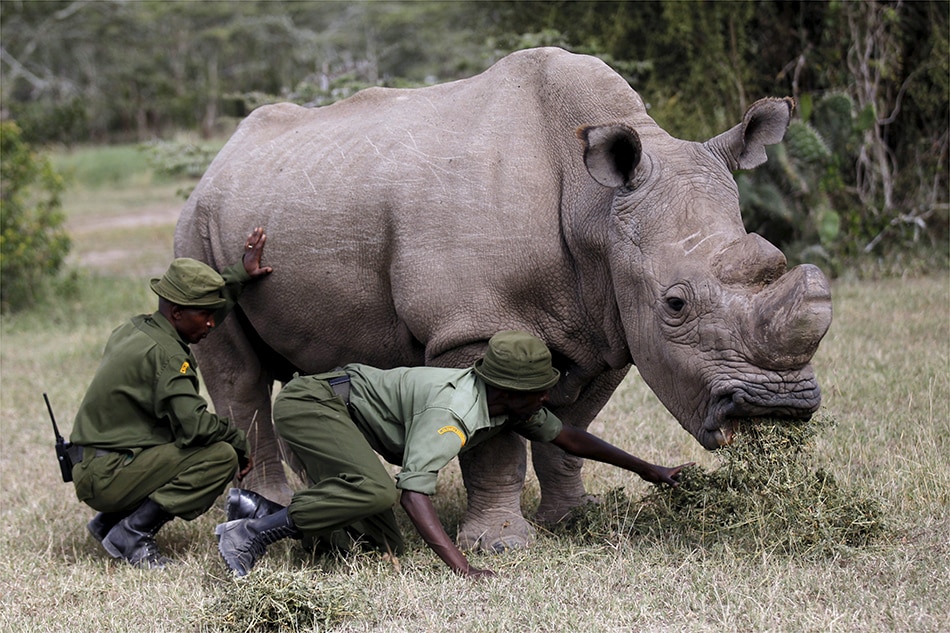Rhinos and their conservation in Kenya | ABS-CBN
ADVERTISEMENT

Welcome, Kapamilya! We use cookies to improve your browsing experience. Continuing to use this site means you agree to our use of cookies. Tell me more!
Rhinos and their conservation in Kenya
Rhinos and their conservation in Kenya
Agence France-Presse
Published Aug 30, 2018 12:09 PM PHT
NAIROBI -- Once it roamed Asia and Africa in the tens of thousands. Today, the rhinoceros has been driven to near-extinction.
NAIROBI -- Once it roamed Asia and Africa in the tens of thousands. Today, the rhinoceros has been driven to near-extinction.
Three of the 5 species of rhino are listed as critically endangered -- their numbers decimated by poachers who kill the giant mammal for its horn, used in traditional Chinese medicine or as a supposed aphrodisiac.
Three of the 5 species of rhino are listed as critically endangered -- their numbers decimated by poachers who kill the giant mammal for its horn, used in traditional Chinese medicine or as a supposed aphrodisiac.
The 2 species found in Africa are the black rhino and larger white rhino, with genetically distinct northern and southern subspecies. Together they number between 25,000 and 30,000 on the continent today.
The 2 species found in Africa are the black rhino and larger white rhino, with genetically distinct northern and southern subspecies. Together they number between 25,000 and 30,000 on the continent today.
Kenya is home to one of the largest populations of rhinos in Africa, after South Africa. It also has only 2 remaining female northern white rhinos, whose species is on the brink of extinction after the last male died in March.
Kenya is home to one of the largest populations of rhinos in Africa, after South Africa. It also has only 2 remaining female northern white rhinos, whose species is on the brink of extinction after the last male died in March.
ADVERTISEMENT
In 1970, Kenya boasted 20,000 black rhinos -- a number which plummeted 98 percent to only 350 in 1983, but has steadily crept up to over 700 due to conservation efforts.
In 1970, Kenya boasted 20,000 black rhinos -- a number which plummeted 98 percent to only 350 in 1983, but has steadily crept up to over 700 due to conservation efforts.
Kenya is a pioneer of the sanctuary approach, placing rhino in fenced-off areas under the close watch of armed rangers equipped with thermal imaging cameras and drones.
Kenya is a pioneer of the sanctuary approach, placing rhino in fenced-off areas under the close watch of armed rangers equipped with thermal imaging cameras and drones.
Ironically, this success comes with its own set of problems as there is limited space for these rhinos. As a result, faced with a burgeoning human population, they cannot roam and expand their gene pool.
Ironically, this success comes with its own set of problems as there is limited space for these rhinos. As a result, faced with a burgeoning human population, they cannot roam and expand their gene pool.
With black rhino populations thriving in parks in Nairobi and Nakuru, the Kenya Wildlife Service (KWS) this year decided to move 14 rhinos to a new sanctuary in Tsavo East, in the southeastern Kenya, in an operation funded by the World Wildlife Fund (WWF).
With black rhino populations thriving in parks in Nairobi and Nakuru, the Kenya Wildlife Service (KWS) this year decided to move 14 rhinos to a new sanctuary in Tsavo East, in the southeastern Kenya, in an operation funded by the World Wildlife Fund (WWF).
KWS has successfully carried out numerous so-called translocations of this kind.
KWS has successfully carried out numerous so-called translocations of this kind.
ADVERTISEMENT
But in this case, all 11 animals which were moved died. The 3 others were not transferred.
But in this case, all 11 animals which were moved died. The 3 others were not transferred.
The figure represents more than the 9 rhino poached in the country in 2017.
The figure represents more than the 9 rhino poached in the country in 2017.
Despite the tragedy, officials underline the country's success in bringing down poaching in recent years, with 59 rhino killed in 2013.
Despite the tragedy, officials underline the country's success in bringing down poaching in recent years, with 59 rhino killed in 2013.
South Africa, home of the largest rhino population, has lost over 1,000 of the animals annually over the past 5 years, according to the group Save The Rhino.
South Africa, home of the largest rhino population, has lost over 1,000 of the animals annually over the past 5 years, according to the group Save The Rhino.
© Agence France-Presse
© Agence France-Presse
ADVERTISEMENT
ADVERTISEMENT



